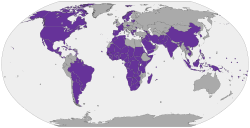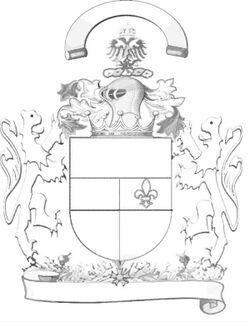Philosophy:Motto

A motto (derived from the Latin muttum, 'mutter', by way of Italian motto, 'word' or 'sentence')[1][2][3][4] is a sentence or phrase expressing a belief or purpose,[1] or the general motivation or intention of an individual, family, social group, or organisation.[2][4] Mottos (or mottoes)[1] are usually found predominantly in written form (unlike slogans, which may also be expressed orally), and may stem from long traditions of social foundations, or from significant events, such as a civil war or a revolution. One motto may be in any language, but Latin has been widely used, especially in the Western world.
Language
Latin has been very common for mottos in the Western World, but for nation states, their official national language is generally chosen. Examples of using other historical languages in motto language include:
- County of Somerset in England: Sumorsǣte ealle (All the men of Somerset), Old English.[5][6]
- South Cambridgeshire in the English Fens: Niet Zonder Arbyt (Nothing without work), Dutch, originally the motto of Dutchman Cornelius Vermuyden, who drained The Fens in the 17th century.[7][8]
- South Africa : ǃke e: ǀxarra ǁke (Unity in diversity), ǀXam.
- Shire of Shetland: Með lögum skal land byggja (By law shall the land be built up), Old Norse.[9]
A canting motto is one that contains word play.[10] For example, the motto of the Earl of Onslow is Festina lente (literally 'make haste slowly'), punningly interpreting 'on slow'.[11] Similarly, the motto of the Burgh of Tayport, Te oportet alte ferri (It is incumbent on you to carry yourself high), is a cant on 'Tayport at auld Tay Ferry', also alluding to the local lighthouse.[12] The motto of the U.S. Federal Bureau of Investigation, Fidelity, Bravery, Integrity, is a backronym of the letters F.B.I.
List of examples

- United in diversity, the motto of the European Union (EU)
- In God We Trust, the motto of the United States (US)
- Je Maintiendrai Châlons (French for "I will maintain Châlons"), often abbreviated as Je maintiendrai (French for "I will maintain"), the motto of the Netherlands
- Dieu et mon droit (French for "God and my right"), is the motto of the monarch of the United Kingdom. It appears on a scroll beneath the shield of the version of the coat of arms of the United Kingdom.
- Unus pro omnibus, omnes pro uno (Latin for "One for all, all for one"), unofficial motto of Switzerland
- Post tenebras lux (Latin for "Light After Darkness"), motto of University of Geneva
- United we stand, divided we fall[clarification needed]
Mottos in heraldry
In heraldry, a motto is often found below the shield in a banderole in the compartment. This placement stems from the Middle Ages, in which the vast majority of nobles possessed a coat of arms complete with a motto. In the case of Scottish heraldry, it is mandated to appear above the crest[13] and is called slogan (see: Slogan (heraldry)). The word 'slogan' is an Anglicisation of the Scottish Gaelic sluagh-ghairm (sluagh "army, host" + gairm "cry").[14] There are several notable slogans which are thought to originate from a battle or war cries. In heraldic literature, the terms 'rallying cry' respectively 'battle banner' are also common.[citation needed] Spanish coats of arms may display a motto in the bordure of the shield.[15]
In English heraldry, mottos are not granted with armorial bearings, and may be adopted and changed at will. In Scottish heraldry, mottos can only be changed by re-matriculation, with the Lord Lyon King of Arms.[16] Although unusual in England, and perhaps outside English heraldic practice, there are some examples, such as in Belgium, of the particular appearance of the motto scroll and letters thereon being blazoned;[17] a prominent example is the obverse of the Great Seal of the United States (which is a coat of arms and follows heraldic conventions), the blazon for which specifies that the motto scroll is held in the beak of the bald eagle serving as the escutcheon's supporter.
-
Motto "Domine dirige nos" (Latin for 'Lord, guide us') below the Coat of arms of the City of London
-
Above the crest is the slogan (see: Slogan (heraldry), most traditional in Scottish heraldry) or the war cry, Arms of Brady Brim-DeForest, Baron of Balvaird
Ships and submarines in the Royal Navy (RN) each have a badge and motto, as do units of the Royal Air Force (RAF).[19][ISBN missing]
Mottos in literature
In literature, a motto is a sentence, phrase, poem, or word; prefixed to an essay, chapter, novel, or the like, suggestive of its subject matter. It is a short, suggestive expression of a guiding principle for the written material that follows.[4]
For example, Robert Louis Stevenson's Travels with a Donkey in the Cévennes uses mottos at the start of each section.[20]
See also
- Epigram
- Epitaph
- Hendiatris
- List of Latin phrases
- List of mottos
- List of national mottos
- Mission statement
- Slogan
- Tagline
References
- ↑ 1.0 1.1 1.2 "motto – Cambridge Dictionary". motto – Cambridge Dictionary. Cambridge, England: Cambridge University Press. 2022. https://Dictionary.Cambridge.org/dictionary/english/motto. Retrieved 1 November 2022.
- ↑ 2.0 2.1 "motto – Oxford Dictionaries". Oxford, England: Oxford University Press. http://www.OxfordDictionaries.com/definition/english/motto.
- ↑ "motto – Merriam-Webster". motto – Merriam-Webster. Merriam-Webster, Incorporated. 2022. http://www.merriam-webster.com/dictionary/motto. Retrieved 1 November 2022.
- ↑ 4.0 4.1 4.2 "Webster's Revised Unabridged Dictionary (1913)". The ARTFL Project. The University of Chicago. http://machaut.uchicago.edu/?resource=Webster%27s&word=motto&use1913=on&use1828=on. [failed verification]
- ↑ "The Danish Invasions". Somerset County Council archives. http://www1.Somerset.gov.uk/archives/ASH/Danishinvs.htm.
- ↑ "Somerset - Coat of arms (crest) of Somerset". Heraldry of the World. 19 March 2019. https://Heraldry-Wiki.com/heraldrywiki/index.php?title=Somerset.
- ↑ "Civic Heraldry of England and Wales – East Anglia and Essex area". http://www.CivicHeraldry.co.uk/east_anglia_essex.html.
- ↑ "South Cambridgeshire". Rural Services Network. http://www.rsnonline.org.uk/performance-profiling/south-cambridgeshire.
- ↑ "Shetland Islands - Coat of arms (crest) of Shetland Islands". Heraldry of the World. 13 October 2020. https://Heraldry-Wiki.com/heraldrywiki/index.php?title=Shetland_Islands.
- ↑ The Manual of Heraldry : being a concise description of the several terms used, and containing a dictionary of every designation in the science. Illustrated by four hundred engravings on wood. (5th ed.). London, England: Arthur Hall, Virtue & Co.. 1800. p. 132. OCLC 1049649069. https://archive.org/details/manualofheraldry00adam. Retrieved 1 November 2022.
- ↑ Mark Antony Lower (October 1860). "Onslow". Patronymica Britannica: A Dictionary of the Family Names of the United Kingdom. London, England: John Russell Smith. ISBN 9780788404566. https://books.google.com/books?id=00cBAAAAQAAJ&pg=PA249.
- ↑ "Tayport - Coat of arms (crest) of Tayport". Heraldry of the World. 13 October 2020. https://Heraldry-Wiki.com/heraldrywiki/index.php?title=Tayport.
- ↑ von Volborth, Carl Alexander (March 1980). Heraldry of the World. Blandford Press. p. 192. ISBN 9780806999609. https://archive.org/details/heraldryworld00volb.
- ↑ Merriam-Webster (2003), p. 1174
- ↑ von Volborth, Carl Alexander (March 1980). Heraldry of the World. Blandford Press. p. 211. ISBN 9780806999609. https://archive.org/details/heraldryworld00volb.
- ↑ Innes-Smith, Robert (1990). An Outline of Heraldry in England and Scotland. Derby, England: Pilgrim Press. p. 14, col 1. ISBN 0-900594-82-9. OCLC 1036776100. https://archive.org/details/outlineofheraldr00inne. Retrieved 1 November 2022. "Mottos are not necessarily hereditary, and can be adopted and changed at will."
- ↑ "USS Winston S. Churchill (DDG-81)". http://www.tioh.hqda.pentagon.mil/Navy/USSWinstonChurchill.htm.
- ↑ "Juhana Herttuan patsas - Pori, Finland – Statues of historic figures". Groundspeak, Inc.. 2022. https://Waymarking.com/waymarks/WMBMC0_Juhana_Herttuan_patsas_Pori_Finland.
- ↑ Cassells, Vic (2000). The capital ships: Their battles and their badges. Kangaroo Press. p. 190.
- ↑ Stevenson, Robert Louis (1907). Travels with a Donkey in the Cevennes. London, England: Chatto & Windus. http://www.gutenberg.org/files/535/535-h/535-h.htm.
 |

![Motto Deus protector noster (Latin for 'God is our protector') below the arms of Pori[18]](/wiki/images/thumb/c/cb/Porin_vaakuna.svg/102px-Porin_vaakuna.svg.png)



